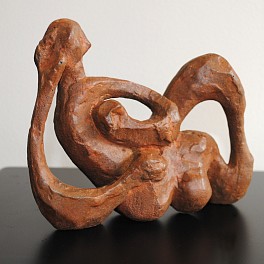BIOGRAPHY

1891 - 1973
Jacques Lipchitz was a French sculptor, widely recognized as one of the major cubist sculptors and the most acclaimed and innovative sculptors of the 20th century.
Of Jewish origin, he was born Chaim Jacob Lipchitz in Druskininkai, Lithuania. At first, under the influence of his father, a building contractor, he studied engineering, but soon after, supported by his mother he moved to Paris (1909) to study at the École des Beaux-Arts and the Académie Julian. There he began to call himself Jacques. It is there, in the artistic communities of Montmartre and Montparnasse that he joined a group of artists that included Juan Gris, Pablo Picasso and Amedeo Modigliani.
In 1911, after learning of his father’s financial difficulties, he returned home briefly to assist the family, but did not remain there long and upon return to Paris, living in a very artistic environment Lipchitz soon began to create Cubist sculptures. In 1912, he exhibited at the Salon National des Beaux-Arts and the Salon d’Automne with his first one-man show held at Léonce Rosenberg’s Galerie L’Effort Moderne in Paris in 1920.
In 1914, he took a trip to Spain with Diego Rivera and friends. At the Prado in Madrid, he was very much impressed by the work of Tintoretto, Rubens, El Greco, Goya and Velazquez. Influenced by Mediterranean life, he created the sculptures Sailor with Guitar, Toreador, and Girl with Braid. After the outbreak of the First World War, he returned to Paris. Between 1915 and 1925, Lipchitz worked in stone, hewing Cubist sculptures with figures and heads reduced to simple, block-like forms and partly polychrome. In 1925, Lipchitz embarked on a series of “transparent” sculptures permeated by space and cast in the lost wax process. With them, Lipchitz detached himself from the formal Cubist language. Angular structures yielded to an unconstrained sculptural style expressed in the free use of natural forms that became increasingly organic.
In 1930, the first large retrospective exhibition of 100 works was held at Jean Bucher’s Galérie de la Renaissance, Paris. The show was favorably received. Around that time he began to explore biblical themes, mythical characters, especially Prometheus and the image of mother and child. In 1934, he exhibited a large scale plaster of David and Goliath at the Salon des Indépendents, Paris.
In 1936 – 37, the French government commissioned him to create a monumental plaster sculpture Prometheus Strangling the Vulture for the entrance to the Science Pavilion at the Paris World’s Fair, the same exposition where Picasso’s Guernica and Gonzales’s Monserrat were shown in the Spanish Pavilion. A room was devoted to his sculptures at “Les Maîtres de L’Art Indépendant” in the Petit Palais at which he was awarded the Gold Medal. At the close of the Fair, the plaster sculpture of Prometheus Strangling the Vulture was destroyed.
With the German occupation of France during World War II, and the deportation of Jews to the Nazi death camps, Jacques Lipchitz had to flee France. With the assistance of the American journalist Varian Fry in Marseille, he escaped the Nazi regime and went to the United States. There, he eventually settled in Hastings-on-Hudson, New York. He was one of 250 sculptors who exhibited in the 3rd Sculpture International held at the Philadelphia Museum of Art in the summer in 1949. In 1954, a Lipchitz retrospective traveled from The Museum of Modern Art in New York to the Walker Art Center in Minneapolis and the Cleveland Museum of Art. In 1959, his series of small bronzes “To the Limit of the Possible” was shown at Fine Arts Associates in New York.
In 1960, a retrospective exhibition of 42 sculptures and numerous drawings was shown in Washington, D.C. and the Baltimore Museum of Art. He visited Italy and began working at the Tommasi Foundry, Pietrasanta, near Carrara. He spent several subsequent summers in Italy, where he began the series of 25 sculptures entitled “Images of Italy”.
1972 was distinguished by a major exhibition organized at the Metropolitan Museum of Art, New York, concurrent with the publication of Lipchitz’s autobiography, “My Life in Sculpture”.
Jacques Lipchitz died on the island of Capri and was buried in Jerusalem.
